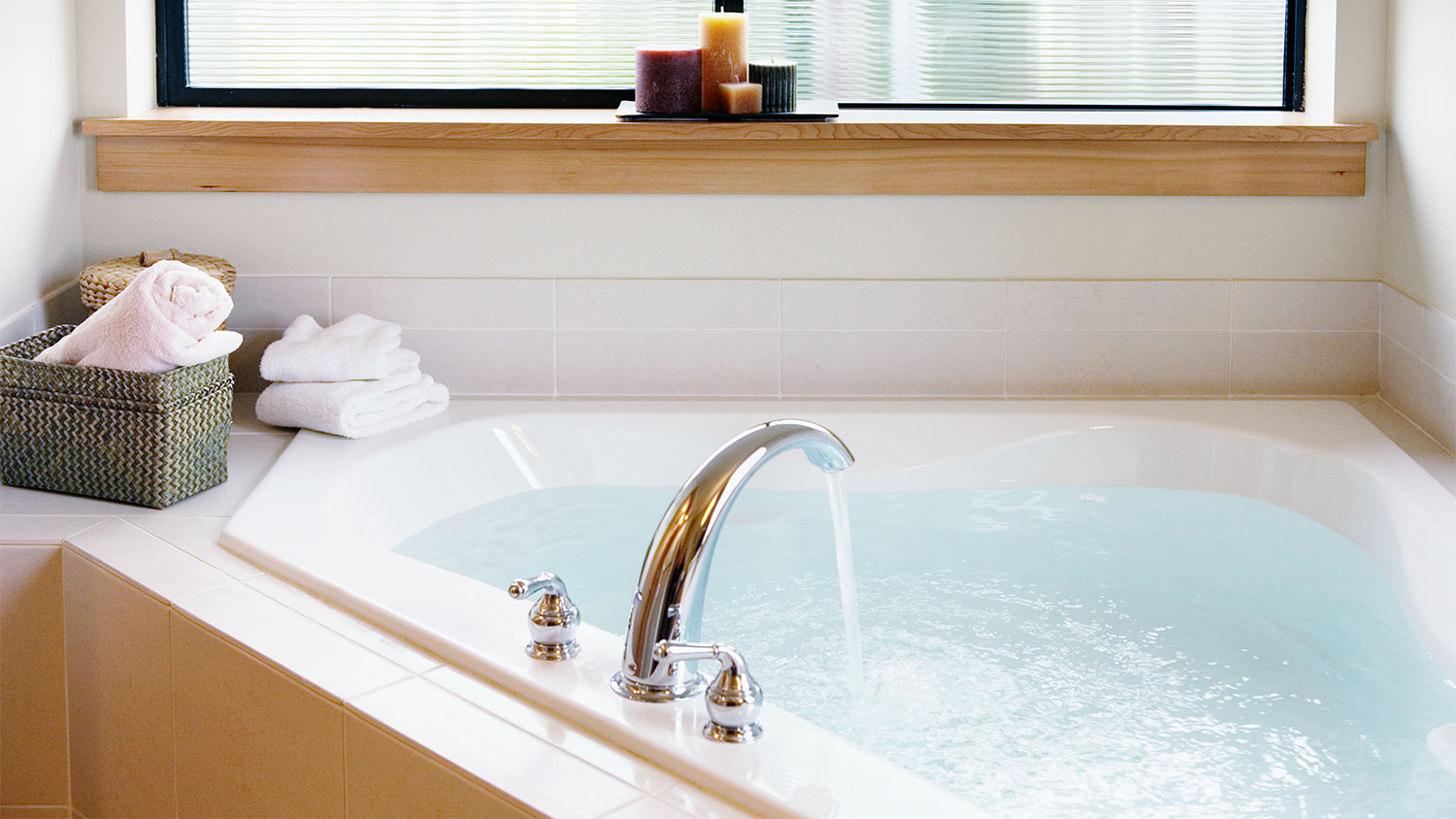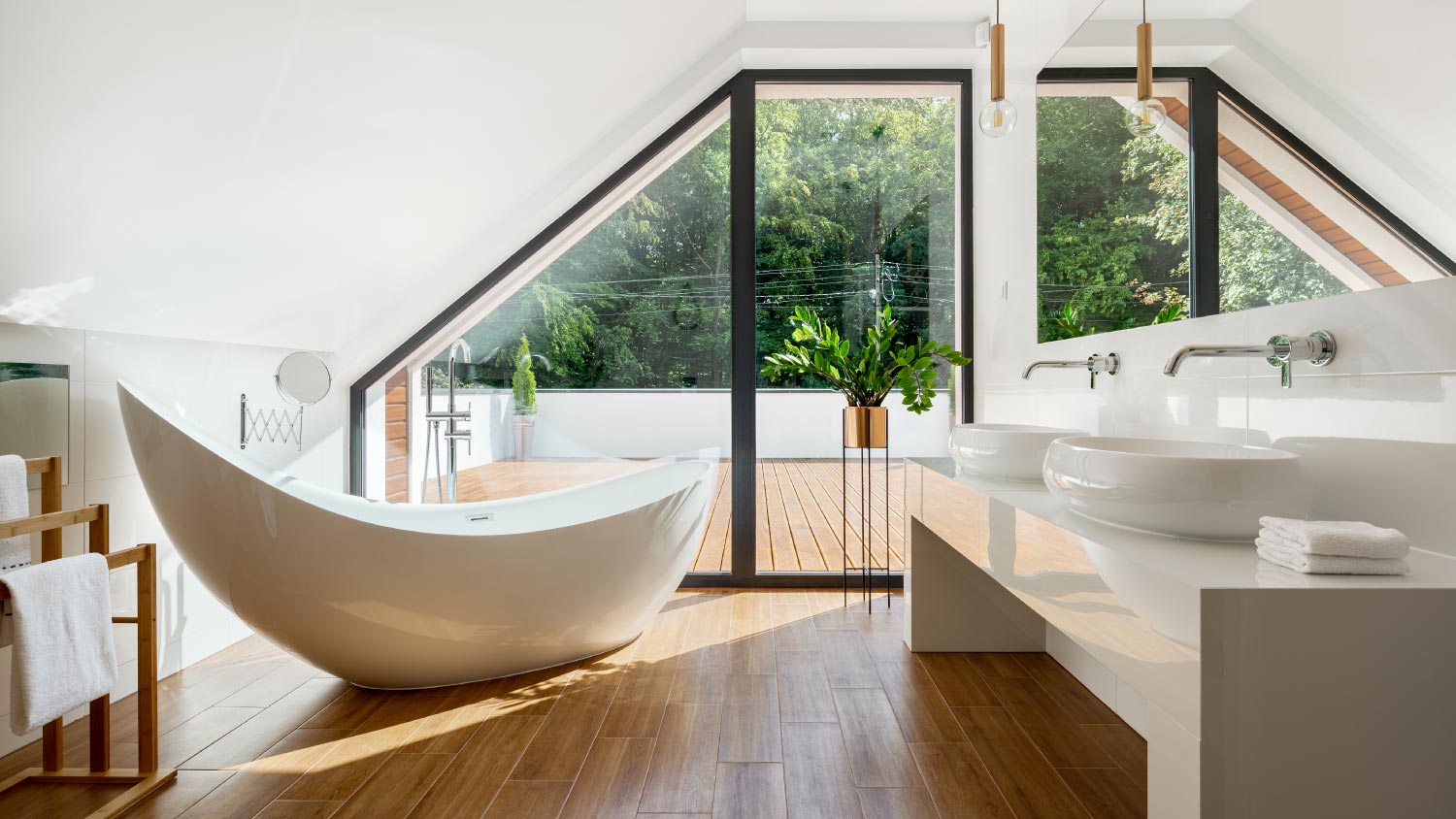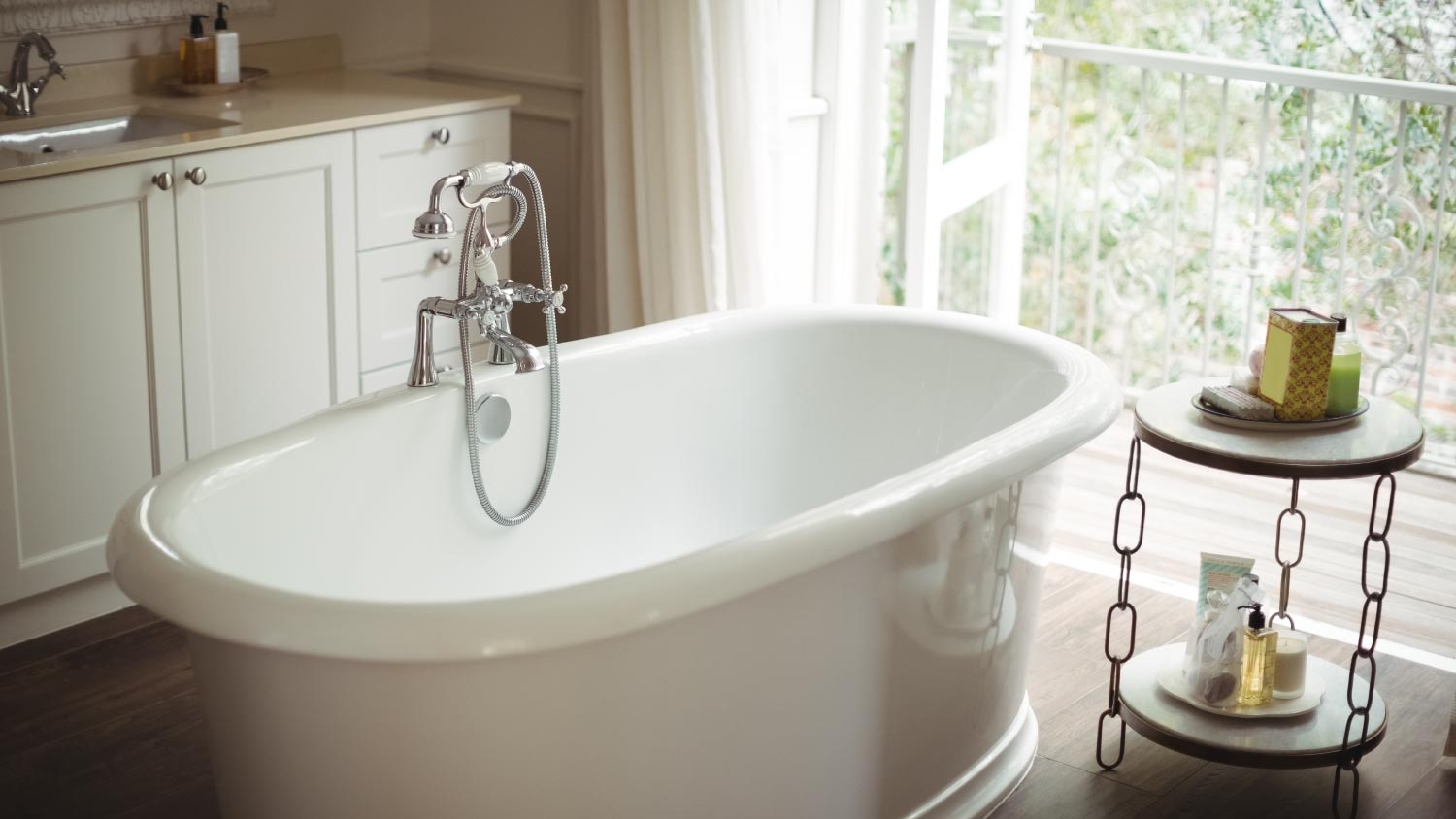
Remodeling your bathroom can add significant value to your home. Your bathroom remodel cost in Columbus, OH will depend on size, fixtures, materials, labor, and other factors.
Both give that bubbly experience, but they have some noteworthy differences


Acrylic tubs come in more versatile styles, and porcelain tubs last for decades.
Acrylic tubs don’t crack or chip but are prone to scratches, while porcelain is the opposite.
Acrylic is a more DIY-friendly option, whereas porcelain requires a professional installation.
When it’s time to replace your tub, it’s smart to pick the best bathtub material for you and your family. If you’ve narrowed down your options to an acrylic versus porcelain tub but aren’t sure how they measure up to each other, this guide will give you insight into what makes each option special and how to choose.
Acrylic and porcelain tubs have some major differences, especially when you compare material, weight, durability, and maintenance. Acrylic bathtubs are made of lightweight plastic that’s reinforced with fiberglass, so they’re easy to install and keep bathwater warmer for longer, but they are prone to scratches and don’t last as long as porcelain. Porcelain tubs are made from cast iron or steel coated in enamel, so they’re heavier and more solid than acrylic. However, they can chip if you drop something heavy on them, and they cost more up front.

An acrylic bathtub is made from a moldable sheet of plastic that manufacturers heat, shape, and reinforce with fiberglass. The result is a bathtub that’s smooth, has a warmer-to-the-touch surface, and is lightweight and easy to install. Acrylic tubs are a popular pick for remodels because they’re affordable, come in many shapes and sizes, and hold heat well for longer soaks.
Let’s look at what to consider when choosing acrylic tubs, what makes them a go-to option for some homeowners, and what you should consider.
Acrylic tubs are made from acrylic sheets that are heated to roughly 392 degrees Fahrenheit, so they’re easier to work with. Manufacturers reinforce the acrylic shell with fiberglass and resin. Because of this process, acrylic tubs can come in any shape, size, or color.
Acrylic tubs weigh 75 to 110 pounds on average, making them one of the most lightweight bathtub materials available. This is a huge plus for homeowners DIYing their bathroom remodel and carrying their tub up or down stairs.
Some homeowners don’t want to shell out big bucks on a new tub but still want a quality choice. On average, standard acrylic bathtubs cost $700 to $1,000, making them an easier option for budget-conscious homeowners.
Have you ever been in the tub only to find that the water felt cold just as you started relaxing? One of the many upsides when comparing acrylic and solid surface tubs is that their nonporous surface doesn’t transfer heat quickly, leaving you with warm, soothing water for longer.
An acrylic tub isn’t vulnerable to weight or impact, so it won’t easily crack or chip under pressure.
While they won’t crack or chip, acrylic bathtubs are vulnerable to scratches. This is something to consider, especially if you have pets or kids who can be rough on a tub.
While acrylic tubs are fairly durable, they’re easier to scratch, can discolor, and may warp over time. With proper maintenance, these tubs last for 10 to 15 years. Consider that you are looking at investing in a new tub every decade.

A porcelain tub has a cast iron or steel base that’s coated with a layer of shiny, baked-on enamel. These bathtubs have a classic, glossy look and feel solid underfoot. While they are durable and scratch-resistant, porcelain tubs can be prone to chipping if you drop something heavy or blunt on them. They’re also a lot heavier to move or install than acrylic tubs. Let’s take a closer look at the pros and cons of porcelain tubs.
Porcelain tubs have a cast iron or metal base with porcelain enamel on top. This coating makes them less prone to scratches.
How long bathtubs last depends on the tub you choose. With proper maintenance, porcelain tubs can last at least 20 years or longer, making them an excellent purchase if you want a tub that can last a lifetime.
If you plan to sell your home, porcelain tubs have great resale value. Since they have a long lifespan, you can mention this added perk to buyers.
Porcelain tubs aren’t as budget-friendly as other bathtub materials. Because of how they’re made and the material used in the process, these tubs can cost $400 to $2,000 or more. Plus, the porcelain enamel could fade, dull, or stain over time, requiring you to refinish it.
The hard surface can make it easier for porcelain to chip and crack. Avoid dropping sharp or hard items on your tub to help increase its lifespan.
Porcelain tubs weigh 200 to 700 pounds, depending on the type and size. So, they’re not a DIY option for homeowners looking for a weekend project. You’ll need to contact a pro who installs bathtubs.
The process involved in designing a porcelain tub gives it a glossy and smooth feel. And while this adds to its charm, it can also cause it to be slippery.
Now that you know what makes acrylic and porcelain worthwhile options for your next bathtub, let’s look at how they compare.
Acrylic bathtubs weigh far less than their porcelain peers. Even the heaviest models don't compare to lightweight porcelain bathtubs.
One of the key reasons homeowners look into DIY projects is so they can do the work themselves. Out of these options, only acrylic tubs make this a feasible DIY bathroom remodel project (with a second pair of hands, of course).
Installing a porcelain tub isn’t a DIY project. With some lighter models weighing roughly 200 pounds, installation can be a safety hazard even with a helper, and you can accidentally drop and break it. Instead, contact a bathtub installer near you so they can safely and correctly install your new soaker.
Acrylic bathtubs retain more heat than porcelain ones. While porcelain bathtubs don’t instantly start losing heat, they don’t stay warm as long as acrylic.
Acrylic bathtubs don’t easily chip or crack, but they’re vulnerable to scratches and stains and can warp over time. Also, improper installation can put these tubs at risk of breaking. Porcelain tubs aren’t easy to scratch but can chip or crack when hit with a heavy or sharp object.
Porcelain versus acrylic bathtubs are fairly similar if you’re looking for a low-maintenance tub. A gentle, nonabrasive cleaner should do the trick for both. Porcelain tubs are more resilient to scratches, so they can handle abrasive cleaners better than acrylic tubs, but you should still stick with nonabrasive cleaners to help prolong the lifespan of your tub. Plus, the porcelain tub’s glossy finish makes it easy to wash off dirt and grime.
Since chemicals can eat away at acrylic surfaces over time, it’s best to use only nonabrasive cleaners that won’t impact the coating. Eventually, you’ll need to refinish both materials, but you can use refinishing kits for the job if you’re an avid DIYer.
Cost plays a major role when weighing the pros and cons of porcelain versus acrylic tubs. An acrylic tub has a low initial cost, but not a long lifespan, so you might need to replace it sooner than anticipated. A porcelain tub is more expensive initially, but can last decades with proper maintenance.
When deciding whether to invest in an acrylic or porcelain bathtub, it depends on your needs. If cost is a dealbreaker, you might be more interested in an acrylic tub that initially costs less than porcelain. If you love taking long baths with water that’s just the right temperature, acrylic is the best bathtub material for heat retention between the two options.
Porcelain tubs might be best if your new tub also needs to accommodate your kids and four-legged family members, since porcelain can hold its own against scratches. It’s also a great option if you’re looking for a tub that has more longevity and can add to your home’s resale value.
If you’re on the fence, consult a bathtub or shower installer near you for advice on how to choose the best bathtub for your home.
Very professional, polite and helpful. I would recommend him!
Raven and crew does absolutely fantastic job. They are very professional if any concerns were to occur with any of her work she always took responsibility and finished out with a great job. I have worked with her business for a year and have always been satisfied. Very trusted business and...
I had Ace Fireplace Services install custom chimney caps for my home, and the results are stunning. They fit like a glove and have added a touch of sophistication to my chimney. I can't recommend their services enough.
Custom Paint Jobs LLC turned our outdated bathroom into a modern masterpiece.
Very professional and efficient with work. Answered each question I had with great knowledge and an informative response. Will be working with them again.
Window Depot did an amazing job on my deck. I wasnt sure what I wanted to do, but their composite decking was affordable and will last a long time. I am excited to have family over, and I am no longer embarrassed by my backyard. Jeff and the ground crew were polite, respectful, and caring for...
Great tree company, very professional and honest. Glad we found them, they had the best pricing
Maple Tree Service should serve as a mentor for other business! Customer service was superior and beyond expectation. Response to request was prompt. The representative was very courteous and proud of the company. Quote was given during initial visit and work date established. A follow up...
Eugene returned my call within minutes and was able to complete the job within a couple of days. Friendly and professional, and I feel his prices are reasonable.
We used Unique Hardwood Floor LLC three years ago to work on the floors of a 70 year old home that needed a great deal of work. Some floors needed repairs, some were replaced and others just needed to be refinished. It was a complicated job as they needed to blend the old and the new to...
From average costs to expert advice, get all the answers you need to get your job done.

Remodeling your bathroom can add significant value to your home. Your bathroom remodel cost in Columbus, OH will depend on size, fixtures, materials, labor, and other factors.

Tiling a shower is an investment in the look and function of your home. This guide explains the factors behind the cost to tile a shower.

A bidet—stand-alone, attachment, spray nozzle, or toilet combo—reduces toilet paper usage and saves money, but how much is a bidet? Here’s how much you’ll pay.

An updated bathtub can give a bathroom a whole new look. Find out how much it costs to replace a bathtub in Charlotte, NC, including prices by type and labor costs.

An updated bathtub can give a bathroom a whole new look. Find out how much it costs to replace a bathtub in Orlando, FL, including prices by type and labor costs.

An updated bathtub can give a bathroom a whole new look. Find out how much it costs to replace a bathtub in Los Angeles, CA, including prices by type and labor costs.